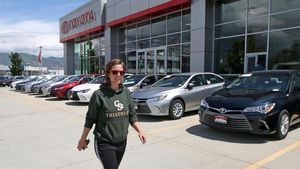The U.S. Department of Transportation has embarked on an ambitious plan to roll out vehicle-to-everything (V2X) technology nationwide, aimed at enhancing road safety and efficiency. Announced on August 16, 2024, the National V2X Deployment Plan is set to change how vehicles communicate with one another, roadside infrastructure, and even pedestrians.
V2X technology allows vehicles to send and receive real-time information, potentially preventing accidents and improving traffic management. This nonbinding roadmap calls for cooperation between various stakeholders, including private companies and government bodies, to streamline V2X integration.
“V2X connectivity is not just about improving safety,” mentioned officials from the DOT. It also involves passenger and freight transportation, aiming to create a smarter, more connected transportation network across the U.S.
At its core, V2X consists of several types of communication: vehicle-to-vehicle (V2V), vehicle-to-infrastructure (V2I), and vehicle-to-pedestrian (V2P). For example, V2V can alert cars to prevent collisions by detecting abrupt braking, whereas V2I can interact with smart traffic systems to optimize travel routes.
Currently, the deployment of V2X technology is limited. Some vehicles, like certain Volvo models, possess basic capabilities to alert drivers about road hazards; but these systems can only communicate with similar brands, raising questions about interoperability.
The DOT plans to expand V2X capabilities on at least 20% of the National Highway System by 2028. This includes fitting major metro areas with technologies capable of managing traffic signals and providing direct connections with vehicles.
By the time we reach 2036, the aim is for V2X technologies to be standard across 100% of the National Highway System. Six different automobile manufacturers are expected to offer models equipped with V2X by then, with at least 20 different models anticipated to be fully V2X-capable.
Transportation officials assert V2X could be pivotal for reducing traffic fatalities, which tragically numbered over 40,000 last year. “This is not just another technology,” insisted Dr. Robert C. Hampshire, the DOT's chief scientist. “This is lifesaving technology.”
Among the primary goals of the plan is to reclaim the 5.9 GHz spectrum, which is primarily allocated for transportation communications. The Federal Communications Commission had reduced availability for this frequency band for other uses, which has created challenges for bandwidth allocation necessary for V2X technologies.
National security concerns are another hurdle for this technology rollout. The Department of Commerce is actively investigating potential risks linked to foreign technologies embedded within connected vehicles, seeking to shield the system from security threats.
“Imagine foreign powers having access to vehicle communication systems; it poses serious risks,” stated U.S. Commerce Secretary Gina Raimondo. The aim is to establish regulations protecting against such vulnerabilities before full-scale implementation occurs.
Meanwhile, various stakeholders, including the National Transportation Safety Board (NTSB), have expressed strong support for this plan. NTSB Chair Jennifer Homendy declared it as “a first step” toward recognizing V2X technology’s lifesaving potential, advocating for its swift and efficient implementation.
Conversely, some experts worry about privacy issues surrounding V2X technology. Cliff Braun from the Electronic Frontier Foundation raised alarms about the vast amounts of data generated by these communications, which could be misused by corporations or governmental agencies.
The need for regulations around data usage will be imperative. Braun emphasized the importance of establishing guardrails concerning how long data can be retained and who can access it.
The plan includes significant funding initiatives; the DOT has already allocated $60 million to several V2X pilot projects across states like Arizona, Texas, and Utah. The initiative looks to leverage additional funding from the Bipartisan Infrastructure Law to bolster V2X technology deployment nationwide.
State agencies will play pivotal roles as they take on responsibilities for infrastructure upgrades and coordination with vehicle manufacturers. They will also need to engage public platforms and the private sector, fostering partnerships to realize the full scope of V2X technology’s capabilities.
Dr. Robert C. Hampshire remarked on the readiness of such technology, claiming it’s not theoretical; V2X systems are actively operational across various setups nationwide. He expects to see more widespread deployment sooner than many anticipate.
Currently, V2X implementation paves the way for safer roads through smart technologies, ensuring timely communication during emergencies. For example, traffic signals could adapt based on approaching emergency vehicles, minimizing delays and enhancing public safety.
Experts foresee deployment plans starting earlier with commercial fleets and gradually transitioning to passenger vehicles by 2028, according to industry forecasts. This phased approach aims to tackle implementation challenges and refine technologies for everyday use.
Stakeholders support these goals, recognizing the potential benefits V2X can bring not only to road safety but also to traffic efficiency. The DOT's plan presents the promise of enhanced mobility for all road users.
One of the notable aspects of the plan includes the monitoring phase, during which performance metrics and challenges will be assessed. Feedback will shape how future development and deployment occur, ensuring technologies meet the diverse needs of communities.
Public comment periods have played a role since the draft plan was put forward. Stakeholders are urging transparency and participation from the public to make informed decisions throughout the entirety of the V2X deployment process.
“Stakeholders across sectors—manufacturers, government agencies, and even academic institutions—are integral to making this work,” mentioned Laura Chase, CEO of the Intelligent Transportation Society of America. The collaboration will facilitate the pathway to deployment more effectively.
While the promise of V2X technology captivates many, stakeholders realize the hurdles remain significant. From regulatory gaps to national security concerns, comprehensive planning will be required to successfully integrate this technology across the United States.
Supporters believe the incredible potential of V2X can reshape American roadways, improving safety and efficiency. “It’s not simply about implementing new technology; it’s about transforming transportation as we know it,” said Michael Graham, NTSB board member.
The conversation surrounding V2X is just beginning, and its transformational potential continues to be at the forefront. With committed efforts, there’s hope for realizing safer and smarter roads for everyone.



